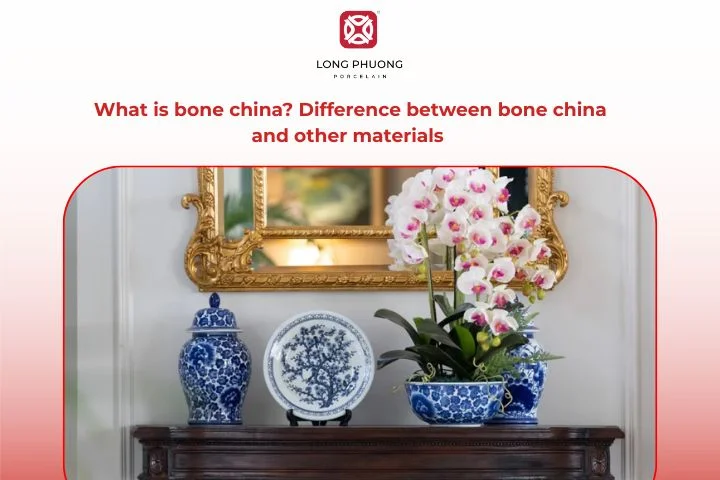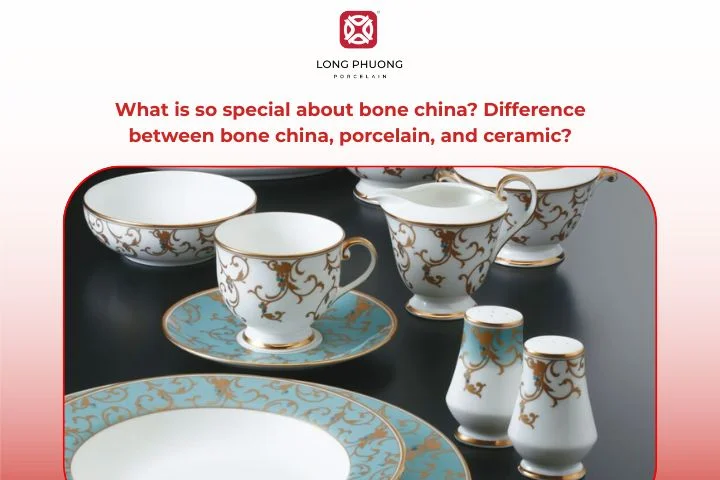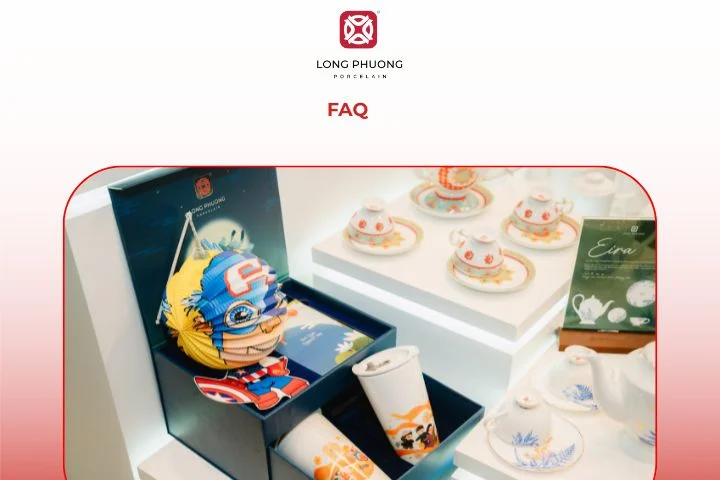Have you ever wondered what makes certain dinnerware sets so thin, translucent, and elegant? Chances are, you’ve encountered a piece of bone china. This material is a staple in luxury dining and fine porcelain collections worldwide. But what is bone china, and how does it compare to other materials like porcelain or ceramic? In this comprehensive guide, Long Phuong Porcelain will answer the question, “what is bone china,” explore its fascinating history, and help you understand why it’s a favorite among collectors and fine diners alike.

1. What is bone china? The history and origin of bone china
So, what is bone china? Bone china is a type of translucent ceramic pottery, primarily made from kaolin (china clay), Cornish stone (a type of feldspathic material), and calcined bone ash. The story of bone china begins in 18th-century England. Porcelain was a highly sought-after commodity imported from China, known for its incredible whiteness and strength.

British potters, eager to replicate this success, experimented with various formulas. The breakthrough came around 1794 when Josiah Spode, a renowned English potter, perfected a formula that included bone ash. The result was a new type of porcelain that was even stronger, more translucent, and whiter than its Chinese counterpart. This new material was named “bone china” and quickly rose to prominence, becoming a symbol of quality and luxury.
See more: What is fine bone china? Everything you’ll need to know
2. What is bone china made of?

The composition is what sets bone china apart. The standard formula consists of:
- Bone Ash (at least 30%): This is the key ingredient, traditionally made from calcined animal bone. The bone ash gives the material its exceptional strength, whiteness, and translucency.
- Kaolin (China Clay): A fine, white clay that provides the body and plasticity for shaping.
- Feldspathic Material: This is a mineral flux that helps the mixture melt and fuse together during firing.
The high percentage of bone ash is what is bone china. This unique composition is responsible for its incredible durability and delicate appearance.
3. The manufacturing process of bone china
After knowing what is bone china, let’s take a look how it was made:
Creating a piece of bone china is a meticulous, multi-step process that requires skill and precision.
- Preparation: The raw ingredients—bone ash, kaolin, and feldspar—are carefully measured, mixed with water, and turned into a smooth slurry.
- Molding: This slurry is then poured into molds or shaped by hand to create the desired form, whether a plate, cup, or bowl.
- Biscuit Firing: The pieces are fired at a lower temperature (around 1200°C / 2200°F). This stage, known as “biscuit firing,” hardens the clay without fully vitrifying it, making it durable enough for handling.
- Glazing: After the first firing, a glaze is applied to the pieces, giving them a smooth, glossy finish.
- Glaze Firing: The pieces are fired again at a slightly higher temperature, causing the glaze to melt and fuse with the ceramic body. This second firing creates the characteristic shiny surface.
- Decoration: If a design is to be added, it is applied after the glaze firing.
- Final Firing: The decorated pieces may be fired one last time to set the final design.
4. What is so special about bone china? Difference between bone china, porcelain, and ceramic?
When exploring what is bone china, it becomes clear that its unique combination of translucency, strength, and elegance sets it apart from porcelain and ceramic.

4.1. Characterics of bone china
The main reason for its popularity lies in its unique properties. It strikes a perfect balance between strength and delicacy, making it both beautiful and practical.
- Translucency: When held up to the light, bone china has a unique, milky translucency. You can often see the shadow of your hand through a thin piece.
- Strength: Despite its delicate appearance, it is incredibly durable and chip-resistant.
- Lightweight: It feels much lighter and more delicate than other types of porcelain.
- Vibrant Whiteness: The bone ash gives it a warm, creamy-white color that makes colors and glazes pop.
4.2. Bone china vs porcelain: Which one is the best choice?
Porcelain is durable and practical for daily use, while bone china feels more refined.
| Feature | Bone China | Porcelain |
| Composition | Includes bone ash (40–50%) | Made of clay, feldspar, kaolin |
| Appearance | Creamy-white, translucent | Bright white, less translucent |
| Strength | Lightweight but strong | Dense and durable |
| Price | More expensive | More affordable |
| Best For | Luxury dining & special occasions | Everyday meals & general use |
4.3. Bone china vs fine china: What’s different?
Fine china looks similar to bone china but lacks bone ash in its formula.
| Feature | Bone China | Fine China |
| Composition | Bone ash + clay + feldspar | Clay + feldspar, no bone ash |
| Strength | Stronger, chip-resistant | More fragile |
| Translucency | High – allows light through | Lower – more opaque |
| Color | Creamy ivory-white | Bright white |
| Price | Higher | Lower |
| Best For | Elegant dining, long-term use | Occasional use, budget option |
4.4. Bone china vs ceramics: Everyday use vs luxury dining
Ceramics are casual and affordable, while bone china offers elegance and prestige.
| Feature | Bone China | Ceramics |
| Composition | Bone ash + clay + feldspar | Clay-based, no bone ash |
| Durability | Thin but durable | Heavier, less refined |
| Appearance | Smooth, translucent | Opaque, thicker |
| Price | Premium, higher cost | Budget-friendly |
| Best For | Formal dinners, luxury dining | Daily family meals |
5. FAQ

5.1. Is bone china still made from bones?
Yes, traditional bone china is still made using calcined animal bone, primarily from cattle.
5.2. What are the disadvantages of bone china?
The main disadvantages are its higher price and the need for careful handling to avoid breakage.
5.3. Can vegans use bone china?
Since bone china contains animal bone ash, it may not align with vegan lifestyles. However, some modern producers are experimenting with alternative materials.
5.4. How to identify bone china?
Look for a few key signs: hold it up to the light to check for translucency, tap it gently for a high-pitched ring, and note its light weight and creamy color.
5.5. What is bone ash in bone china?
Bone ash is the result of heating animal bones to a high temperature, which turns them into a white, powdered substance rich in calcium phosphate. This is the crucial ingredient that gives bone china its unique qualities.
5.6. Which is more expensive bone china or porcelain
Typically, bone china is more expensive due to its specific composition and complex production process.
6. Recommendation porcelain tableware set inspiration for your dining table
Now that you know what is bone china, you might be considering a new dinnerware set. While bone china is a luxurious choice, high-quality porcelain also offers incredible beauty and durability for everyday life.

If you’re looking to elevate your dining experience, explore the timeless collections from Long Phuong Porcelain. Our exquisite porcelain tableware is known for its elegant design, durability, and a classic style that can suit any home. From minimalist dinner sets to beautiful platters, we have the perfect pieces to help you create unforgettable moments around your dining table.
Shop our porcelain collection today and discover the perfect blend of elegance and quality.
Long Phuong Group Joint Stock Company
- Phone number: (+84) 989 595 866
- Email: export@longphuong.vn
- Factory: Hap Linh Industrial Cluster, Hap Linh, Bac Ninh, Vietnam
- Showroom Ha Noi: 59 Cua Bac, Ba Dinh Ward, Hanoi, Vietnam
- Showroom Ha Noi: 37 Cua Nam, Cua Nam Ward, Hanoi, Vietnam
- Showroom TP. Ho Chi Minh: 127 Le Thi Rieng, Ben Thanh Ward, Ho Chi Minh, Vietnam
Related Posts
CEO of Long Phuong Group Joint Stock Company, with more than 20 years of exploration and research to obtain the best formulas and professional experience, Long Phuong Porcelain has produced more than 400 designs of all kinds of household porcelain, Significant contributions to Vietnam's ceramic industry.
 Vietnam
Vietnam
